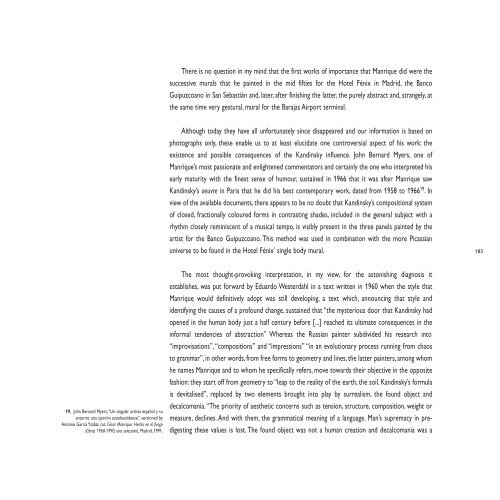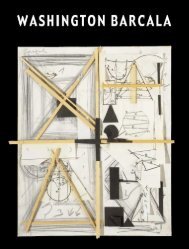VERSIÓN INGLESA ENGLISH VERSION - Fundación César Manrique
VERSIÓN INGLESA ENGLISH VERSION - Fundación César Manrique
VERSIÓN INGLESA ENGLISH VERSION - Fundación César Manrique
You also want an ePaper? Increase the reach of your titles
YUMPU automatically turns print PDFs into web optimized ePapers that Google loves.
19. John Bernard Myers, “Un singular artista español y su<br />
entorno: una opinión estadounidense”, versioned by<br />
Antonio García Ysábal, cat. <strong>César</strong> <strong>Manrique</strong>. Hecho en el fuego<br />
(Obras 1968-1990, una selección), Madrid, 1991.<br />
There is no question in my mind that the first works of importance that <strong>Manrique</strong> did were the<br />
successive murals that he painted in the mid fifties for the Hotel Fénix in Madrid, the Banco<br />
Guipuzcoano in San Sebastián and, later, after finishing the latter, the purely abstract and, strangely, at<br />
the same time very gestural, mural for the Barajas Airport terminal.<br />
Although today they have all unfortunately since disappeared and our information is based on<br />
photographs only, these enable us to at least elucidate one controversial aspect of his work: the<br />
existence and possible consequences of the Kandinsky influence. John Bernard Myers, one of<br />
<strong>Manrique</strong>’s most passionate and enlightened commentators and certainly the one who interpreted his<br />
early maturity with the finest sense of humour, sustained in 1966 that it was after <strong>Manrique</strong> saw<br />
Kandinsky’s oeuvre in Paris that he did his best contemporary work, dated from 1958 to 1966 19 . In<br />
view of the available documents, there appears to be no doubt that Kandinsky’s compositional system<br />
of closed, fractionally coloured forms in contrasting shades, included in the general subject with a<br />
rhythm closely reminiscent of a musical tempo, is visibly present in the three panels painted by the<br />
artist for the Banco Guipuzcoano. This method was used in combination with the more Picassian<br />
universe to be found in the Hotel Fénix’ single body mural.<br />
The most thought-provoking interpretation, in my view, for the astonishing diagnosis it<br />
establishes, was put forward by Eduardo Westerdahl in a text written in 1960 when the style that<br />
<strong>Manrique</strong> would definitively adopt was still developing, a text which, announcing that style and<br />
identifying the causes of a profound change, sustained that “the mysterious door that Kandinsky had<br />
opened in the human body just a half century before [...] reached its ultimate consequences in the<br />
informal tendencies of abstraction” Whereas the Russian painter subdivided his research into<br />
“improvisations”, “compositions” and “impressions” “in an evolutionary process running from chaos<br />
to grammar”, in other words, from free forms to geometry and lines, the latter painters, among whom<br />
he names <strong>Manrique</strong> and to whom he specifically refers, move towards their objective in the opposite<br />
fashion: they start off from geometry to “leap to the reality of the earth, the soil. Kandinsky’s formula<br />
is devitalised”, replaced by two elements brought into play by surrealism, the found object and<br />
decalcomania. “The priority of aesthetic concerns such as tension, structure, composition, weight or<br />
measure, declines. And with them, the grammatical meaning of a language. Man’s supremacy in predigesting<br />
these values is lost. The found object was not a human creation and decalcomania was a<br />
183
















![Becas y premios de la Fundación César Manrique [1997-2006]](https://img.yumpu.com/20766851/1/184x260/becas-y-premios-de-la-fundacion-cesar-manrique-1997-2006.jpg?quality=85)
